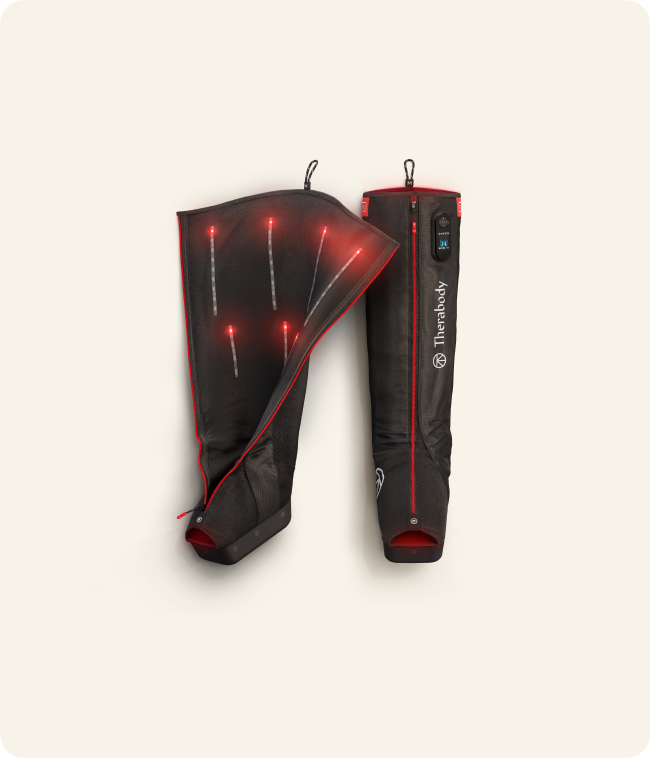
Should You Cycle-Sync Your Workouts? Science & Expert-Backed Insights
Authors: Therabody Scientists: Rachelle Reed, PhD, MS, ACSM-EP; Michelle Darian, MS, MPH, RD, LDN; Tim Roberts, MSc
For far too long, many women have felt like they are at the mercy of their menstrual cycle — from avoiding certain clothing when bloated to missing events because of cramping. Everything can feel like an uphill battle with our bodies, especially workouts.
Enter “cycle syncing.” Cycle syncing can be defined as systematically adapting your lifestyle to each phase of the menstrual cycle. Syncing workouts to your menstrual cycle has recently gained popularity as a way to enhance performance and recovery.
While some women swear by it, the current scientific evidence may not be strong enough to recommend cycle syncing as a one-size-fits-all solution.
Let’s break down the nuances of cycle syncing (according to the research and experts) and explore the menstrual cycle’s impact on fitness and performance to help you decide if this approach might be worth considering for your personalized fitness program.
The differences between menstrual cycle phases
To best understand cycle syncing, it’s important to have a thorough understanding of the differences between the menstrual cycle phases, and what’s going on in the body during each.
There are a few ways of knowing what phase of your cycle you’re in, including an app, a wearable device, or taking your basal body temperature (the lowest temperature your body reaches while at rest).
The phases of the menstrual cycle are driven by changing hormone levels (including estrogen and progesterone), which have far-reaching effects on the body. [1]

Before we dive into the hormonal shifts, symptoms, and timeframes associated with each phase of the menstrual cycle, it’s important to note that this can differ greatly between women (and can even differ in one woman from cycle to cycle).
“While there are general trends — like the potential for increased energy and strength in the follicular phase or feeling more fatigued during the luteal phase — these trends are not universal, notes Amanda Howell, MPH, GGS-1 CPPC PN1.
“Every individual’s experience of their menstrual cycle is unique, and things like hormonal birth control, chronic health conditions, stress levels, and lifestyle factors can dramatically influence how someone feels or performs during different phases and month-to-month.”
With that said, here’s an overview of what can happen physiologically during a 28-day menstrual cycle.
Menstruation
What is it? Days 1-7 where the shedding of the uterine lining occurs
Hormone profile: Low estrogen and progesterone
How you feel: Women may feel crampy, lethargic, fatigued, bloated, or prone to headaches
Follicular phase
What is it? The 7-10 days following menstruation when the body starts building the uterine lining. This is specifically known as the late follicular phase — the full follicular phase includes menstruation
Hormone profile: Rising estrogen, low progesterone
How you feel: Women often feel increased energy, focus, stamina, and strength performance during this time [2]
Ovulation
What is it? Around day 14, when the mature egg is released from the ovary
Hormone profile: Estrogen levels peak, there’s a spike in luteinizing hormone (LH), and progesterone levels start to rise
How you feel: Women often have high energy levels and even an increase in libido. Some people also experience ovulation pain.
Luteal phase
What is it? The about 13 days post ovulation as the body prepares for a potential pregnancy
Hormone profile: High progesterone and moderate estrogen before both drop (if pregnancy doesn’t occur)
How you feel: As hormone levels drop closer to your period, you might experience PMS — mood changes, bloating, fatigue, cramps, and irritability. Women may also feel less motivated and more sensitive to stress. [3]
What are cycle synced workouts?
Syncing your workouts to your cycle means adjusting your type, intensity, or volume of workout(s) (yoga, HIIT, strength, pilates, etc.) to the cycle phase you’re currently in.
For example, women may prioritize HIIT classes or heavy weightlifting during their follicular phase when they typically feel more energetic and opt for lower intensity movement like pilates or yoga when they’re feeling more run-down or fatigued in the luteal phase.
Theoretically, structuring workouts around your cycle may have some physiological benefits.
“There’s been a lot of interest in how different phases of the menstrual cycle might influence how our muscles respond to resistance training. Some have hypothesized that the follicular phase, when estrogen peaks, could be more beneficial for building muscle compared to the luteal phase when progesterone levels are higher,” says Susie Reiner, PhD, CSCS, EP-C.
Estrogen is considered an anabolic hormone — meaning its presence helps you build muscle and bone. [4] Progesterone on the other hand, has been shown to have catabolic effects, meaning it may promote muscle-protein breakdown. [5]
“But scientifically, there’s no strong evidence to suggest one phase is superior for muscle growth,” notes Dr. Reiner.
The research on what actually happens during cycle-synced workouts is still emerging and mixed.
The science of cycle syncing your workouts
“The science behind cycle syncing is new, largely because women have historically been excluded from research studies,” says Howell. “Only recently have we started to see meaningful inclusion of women in studies on performance, recovery, and hormonal health, which means we don’t yet have a large pool of data to draw conclusions.”
With that said, here’s what we know so far.
Muscle protein synthesis
So, what do we know about muscle synthesis and breakdown (important components of how the body builds and maintains muscle mass) during different cycle phases?
We know that strength training stimulates muscle protein synthesis. Other factors like eating a nutrient-dense diet with a balance of protein, carbohydrates, and fats also contribute. [6]
A 2024 study including 12 women ages 18 to 30 (with no current or recent use of hormonal contraceptives) looked at how strength-based exercise impacted muscles during the follicular and luteal phase. [7]
The study results showed that a strength-based leg exercise increased muscle protein synthesis similarly in both the follicular and luteal phases (with no effect on muscle protein breakdown).
Similar results were found in a 2006 study of 15 young healthy women — menstrual cycle phase didn’t impact myofibrillar protein or muscle collagen synthesis in women. [8]
Summary: While fluctuations in estrogen and progesterone may impact your energy and drive for certain workouts, current evidence doesn't show differences in muscle protein synthesis between cycle phases.
Performance
A 2020 meta-analysis (pooled analysis) of 51 studies looked at whether different phases of the menstrual cycle affect exercise performance in women with a natural cycle. They measured everything from cardiovascular and muscular stamina to the maximum force you can exert while lifting or jumping. [9]
Overall, this study found that a slight performance dip might occur during menstruation itself (days 1 – 7), though minor and not universal.
And because the menstrual cycle looks different for every woman, it’s also important to understand how women feel that their cycle impacts their physical performance.
A 2020 study of 15 elite female rugby players looked at their perceived effects of the menstrual cycle on exercise performance. [10]
Nearly all women (93%) reported experiencing menstrual cycle-related symptoms, with 33% reporting heavy menstrual bleeding and 67% reporting that these symptoms impaired their performances.
Summary: Exercise performance may be impacted during menstruation, though current data is limited and likely varies significantly between individuals (and cycles).
Recovery and injury
Recovery refers to how efficiently your body returns to a balanced state after the stress of a workout. [11]
Research on the link between menstrual cycle phases and recovery is also limited.
One study of 13 women who exercise regularly found that recovery after high-intensity intervals was less efficient during the mid-luteal phase when progesterone is the highest. [12]
The likelihood of injury may also be higher during the luteal phase. A study published in 2024 followed 26 female soccer players and tracked data from 593 menstrual cycles. [13] They compared specific injury risks to the menstrual phase. Here’s what they found:
- Injuries were 6 times more likely to occur in the late luteal phase right before menstruation (when estrogen and progesterone decline) than in the menstrual phase.
- Non-contact injuries like sprain and strain muscle or ligament issues, tendonitis, and stress fractures were more likely to occur before menstruation than in the menstrual phase.
- Muscle injuries and short-term injuries were also more likely in the luteal phase.
Summary: While these studies only include women who exercise hard frequently, the evidence points to a possible increase in injury risk during the luteal phase compared to the menstrual phase.
Scientific research on the cycle’s impact on performance and recovery is still evolving
It’s important to note that many of the studies presented here involve a relatively small number of participants over short time frames.
Studies to date typically include women who are highly trained — meaning these results may not be generalized to those exercising recreationally — even if you maintain a regular exercise schedule.
These studies also tend to include women with a natural menstrual cycle who aren’t currently using hormonal contraceptives (like the pill, patch, implant, and IUD) — which can alter the cycle’s hormone patterns. So, study findings may not be generalizable to those on hormonal contraceptives.
"The evidence we currently have available surrounding cycle syncing is not quite comprehensive enough to offer a population-level recommendation. As studies continue to be published on this topic, experts will take those new findings into consideration as they build a more robust evidence base," says Brittany Leboeuf, PhD, MS.
So, should I be syncing my workouts to my cycle?
Cycle syncing is nuanced, and there isn’t a right or wrong way to approach it. The best approach is the one that makes sense for you.
Your physiology impacts how you feel — and that’s ok.
- The concept of cycle syncing acknowledges that you may not show up as your best, most energized, most motivated self to a workout every day, and that’s ok.
- The patterns in your physical and mental well-being throughout your menstrual cycle are great feedback to be aware of. They let you make informed decisions — including how and when you work out.
“The underlying concept of being more in tune with your body — your energy levels, your cravings, how you feel in each phase — is empowering,” emphasizes Howell. “When applied with nuance and flexibility, I find that aspect of cycle syncing beneficial and worthwhile.”
Experts are also careful to note potential downsides to this structure.
“Blanket statements like ‘you shouldn’t lift heavy during your luteal phase’ or ‘you should only do yoga on your period’ aren’t supported by strong evidence," says Howell.
In fact, she believes this prescriptive messaging could discourage women from exploring strength training altogether. Strength training is vital for building and maintaining lean mass, which are key predictors of longevity, especially in women.
Dr. Reiner agrees. “Resistance training works across all phases, so the most important factor remains consistency in your training routine.”
However, your individual experience still matters.
How to adjust your workout to your cycle
Here are a few tips from the experts on how to get started.
“If you notice that certain phases of your cycle feel harder — like workouts are more exhausting or you’re unable to hit your usual numbers — it’s okay to adjust,” says Dr. Reiner. “Consider lowering the intensity, reducing the volume, or swapping in exercises that feel more manageable on those days.”
She points out that these adjustments are usually only needed for a day or two — not for entire phases of the menstrual cycle.
Howell shares similar sentiments, noting, “It’s important to prioritize flexibility and avoid letting cycle syncing become restrictive or stressful.”
What’s best for you
Women experience a range of symptoms when it comes to their menstrual cycle, and some may notice no symptoms at all. Dr. Reiner notes that these symptoms “can differ not only between women but even from one cycle to the next for the same person.”
There’s no one-size-fits-all approach. Both Howell and Dr. Reiner emphasize that rigid cycle syncing automatically excludes certain exercises (like strength training) regardless of how you’re feeling. It can mean that women are under training and missing out on the benefits of those workouts.
One person may need to take it easier during ovulation if they experience ovulation pain. Someone who has cramps on day one of their period may just prefer to go for a walk that day. And what if you sleep poorly during your follicular and don’t feel energized for your HIIT class? You can make an adjustment to your routine then, too.
“Ultimately, the most reliable "science" is paying attention to your own body,” concludes Howell.
Key takeaways
- Syncing workouts to your menstrual cycle is a new-ish practice that's piqued the interest of women.
- It includes prioritizing high-energy, high-intensity movement during the follicular phase when estrogen is high, and lower-intensity workouts when progesterone is high (and then when both hormones dip).
- However, scientific research on this topic is not robust.
- Studies currently indicate minor to no differences in performance between phases and no differences in the ability to build muscle.
- On the other hand, some studies show that recovery is less efficient, and injuries are more likely during the luteal phase.
- Experts agree that allowing for flexibility in your workout schedule based on menstrual cycle symptoms is helpful, but a rigid cycle syncing approach may leave you missing out on the benefits of a consistent strength training routine.
- Based on your lifestyle, symptoms, and goals, it’s your choice whether cycle-syncing your workouts is something to pursue.
References:
- https://www.ncbi.nlm.nih.gov/books/NBK500020/
- https://www.mdpi.com/2075-4663/12/1/31
- https://pmc.ncbi.nlm.nih.gov/articles/PMC8906247/
- https://pmc.ncbi.nlm.nih.gov/articles/PMC6341375/
- https://pubmed.ncbi.nlm.nih.gov/7039319/
- https://pubmed.ncbi.nlm.nih.gov/11255140/
- https://pmc.ncbi.nlm.nih.gov/articles/PMC11870050/
- ttps://journals.physiology.org/doi/full/10.1152/ajpendo.00300.2005
- https://pubmed.ncbi.nlm.nih.gov/32661839/
- https://bjsm.bmj.com/content/54/18/1108
- https://pmc.ncbi.nlm.nih.gov/articles/PMC5932411/
- https://pmc.ncbi.nlm.nih.gov/articles/PMC9959793/
- https://pubmed.ncbi.nlm.nih.gov/38227488/





